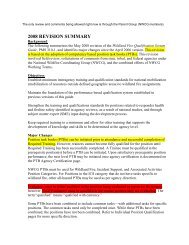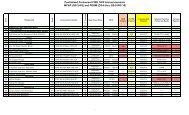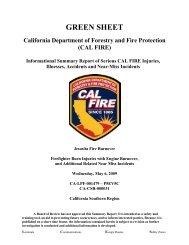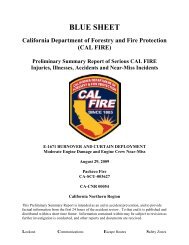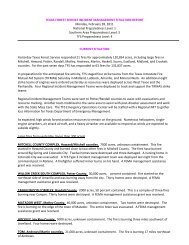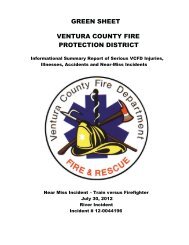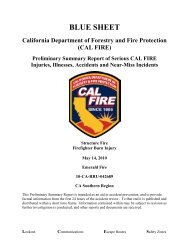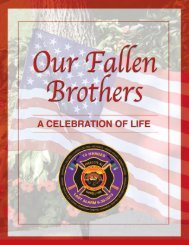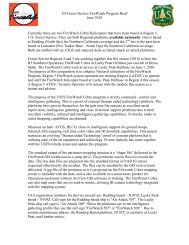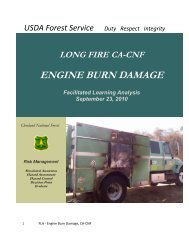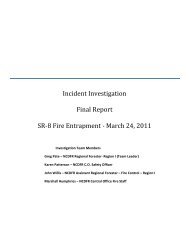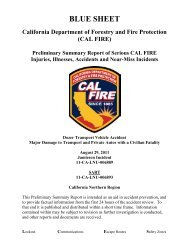EPH Safety Issue - Wildland Fire
EPH Safety Issue - Wildland Fire
EPH Safety Issue - Wildland Fire
You also want an ePaper? Increase the reach of your titles
YUMPU automatically turns print PDFs into web optimized ePapers that Google loves.
National Interagency Incident Communications Division<br />
May 22, 2012<br />
To:<br />
From:<br />
Subject:<br />
Radio Users<br />
Stephen M. Jenkins, Chief, National Interagency Incident<br />
Communications<br />
Relm BK <strong>EPH</strong>/EMH Radio Interstitial Frequency <strong>Safety</strong> <strong>Issue</strong><br />
<strong>Issue</strong>: The Relm BK <strong>EPH</strong>/EMH radio will not tune to FCC-issued interstitial<br />
frequencies in use by state and local agencies. If a technician uses the PC<br />
programming software to program a channel to an interstitial frequency, that<br />
channel will contain a random frequency, with no indication that an error occurred<br />
from either the PC programming software or the <strong>EPH</strong>/EMH radio. The affected<br />
radio will appear to function on that channel, but the transmitter and receiver will<br />
be on the wrong frequency, jeopardizing the safety of the radio user. The only way<br />
to know that an error occurred is to inspect the radio configuration via front panel<br />
programming or to read the radio configuration back into the PC programmer. The<br />
channel that was programmed with an interstitial frequency will have a different<br />
frequency than the one entered. If a technician attempts to program an interstitial<br />
frequency via front panel programming the radio will not accept it. If an interstitial<br />
frequency is cloned into an <strong>EPH</strong> radio, the radio will program itself to the next<br />
valid frequency.<br />
Identifying interstitial frequencies: An interstitial frequency is any frequency in<br />
the FCC public safety band (150 - 162 MHz) that has a five in the fourth decimal<br />
place. For example 155.7525 is an interstitial; 155.7450 is not. Note that federal<br />
frequencies (162 to 174 MHz) with a five in the fourth decimal place are not<br />
interstitial (e.g. 166.6125) and are compatible with the <strong>EPH</strong>/EMH radio.<br />
Discussion: The issue of interstitial frequency radio incompatibility was first<br />
identified in 2007 and information was posted to the National Interagency <strong>Fire</strong><br />
Center (NIFC)/National Interagency Incident Communications Division (NIICD)<br />
NIFC/NIICD Hot Sheet. It was noted in the Hot Sheet that the <strong>EPH</strong> was incapable<br />
of tuning to FCC-licensed interstitial frequencies and that interstitial frequency<br />
assignments would increase over time. The problem with the PC programmer was<br />
not discussed because it had not yet been identified. It was recommended that
<strong>EPH</strong> radios be replaced as soon as budgets allow. The DOI lifecycle replacement<br />
of portable radios is 7 years and the US Forest Service lifecycle replacement for<br />
radios is 10 years. Relm/BK states that the last <strong>EPH</strong> radio was shipped in 1998.<br />
State and local agencies are completing the FCC-mandated migration to<br />
narrowband. Consequently, interstitial frequency assignments are increasing.<br />
Since the <strong>EPH</strong>/EMH cannot be programmed to these frequencies, it can no longer<br />
be considered an effective tool for interagency wildland fire communications.<br />
Continued use of the <strong>EPH</strong>/EMH will create problems with<br />
interoperability, complicate frequency management, and impede mutual aid.<br />
Outcome: Effective January 1, 2013 the <strong>EPH</strong>/EMH will be removed from the<br />
NIFC/NIICD Approved Radio list. <strong>Wildland</strong> fire contractors who are required to<br />
provide radios from the NIFC/NIICD Approved Radio list need to plan<br />
accordingly for the 2013 fire season.<br />
Recommendations:<br />
1. Radio management personnel need to identify any incompatible FCC-licensed<br />
frequencies being used as part of mutual aid agreements with state and local<br />
entities and make radio users aware of the limitations of <strong>EPH</strong>/EMH radios.<br />
2. Communications unit leaders need to identify on their Incident Radio<br />
Communications Plan (ICS 205) any incompatible FCC-licensed frequencies being<br />
used on the incident and make incident radio users aware of the limitations of<br />
<strong>EPH</strong>/EMH radios.<br />
3. Ensure <strong>EPH</strong>/EMH radios are replaced with newer radio models no later than<br />
January 1, 2013. After this date, only radios which are fully compatible with<br />
interstitial frequencies will be placed on the NIFC/NIICD Approved Radio list.<br />
Questions concerning this issue can be directed to the Communications Duty<br />
Officer (208-387-5644) cdo@fs.fed.us.<br />
/s/ ST<strong>EPH</strong>EN M. JENKINS<br />
Chief, NIICD/NIFC



